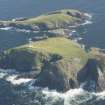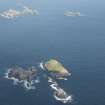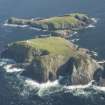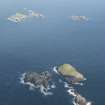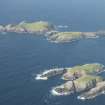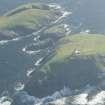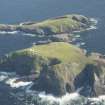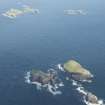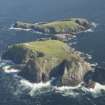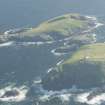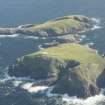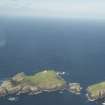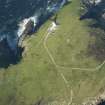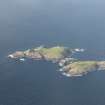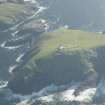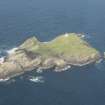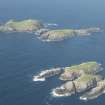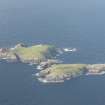Flannan Isles, St Flannan's Chapel
Chapel (Medieval)
Site Name Flannan Isles, St Flannan's Chapel
Classification Chapel (Medieval)
Alternative Name(s) Flannain Isles; Teampull Beannachadh; St Flann's Chapel
Canmore ID 3971
Site Number NA74NW 1
NGR NA 72628 46837
Datum OSGB36 - NGR
Permalink http://canmore.org.uk/site/3971
- Council Western Isles
- Parish Uig
- Former Region Western Isles Islands Area
- Former District Western Isles
- Former County Ross And Cromarty
FLANNAN ISLES (off Lewis) also known as THE SEVEN HUNTERS Named after the 7th century Irish saint, this group of sea-pounded crags was regarded as a refuge of great sanctity, as well as being a rich source of seabirds for Lewismen, who also pastured their sheep here.
EILEAN MOR, the main isle, comprises 39 acres and has no sheltered landing place. David A Stevenson's Lighthouse, 1896-9 (automated 1971) towers atop 300 ft cliffs. It is a place haunted by the unsolved mystery of the three lighthouse keepers, who disappeared in December 1900. An uneaten meal lay on the table, a chair had been overturned, and two sets of oilskins were missing, but all three men had vanished and no trace of them has ever been found. Below the lighthouse, Teampall Beannachadh (blessing house) - the Chapel of St. Flannan - is a drystone-walled structure with a roughly remade vaulted slab roof, a door in its west end. On Maol nam Both, a headland beyond a now fragmentary retaining wall, the Clan Macphail bothies are said to be the remains of two monks' cells, part of a small early Celtic monastic settlement, although for centuries they have been used as shelters by fowlers
Taken from "Western Seaboard: An Illustrated Architectural Guide", by Mary Miers, 2008. Published by the Rutland Press http://www.rias.org.uk
Field Visit (21 October 1924)
Chapel, Flannain Isles.
On Eilean Mor, the larger of the two islets that comprise the Flannain Isles, stand the remains of a tiny chapel. Single chambered and rectangular on plan, it measures only 5 by 7 ¾ feet within walls 26 to 30 inches in thickness. The doorway, 35 inches in height and 24 inches in greatest width, built with slightly inclined jambs, is centred in the west gable and is the only opening in the building. The roof, which had fallen, has been roughly rebuilt. It was built with thin flat slabs in cantilever construction and rose externally to the height of the gables, 8 feet 10 inches. The masonry is drystone and is rude in character, giving no clue as to the date of the structure.
RCAHMS 1928, visited 21 October 1924.
[NB 'the report on structures in the Flannain Isles is based on information and photographs supplied by Mr Cadger, District Superintendant of Lighthouses, through the friendly co-operation of Mr J Dick Peddie, Secretary to the Northern Lighthouse Board (RCAHMS 1928, vi)]
Desk Based Assessment (1970)
NA74NW 1 7262 4684
(NA 7260 4674) Beannachadh (NR) (Remains of)
OS 6" map, (1965).
For well (possibly associated) at NA 7238 4683, see NA74NW 2.
Teampull Beannachadh or St Flann's Chapel (T S Muir 1885) an early, Irish type oratory, rectangular on plan and corbelled, the roof having been mostly rebuilt. It measures only 5' by 7 3/4' within walls 26" to 30" in thickness. The doorway, 35" in height and 24" in greatest width, is in the west gable and has slightly inclined jambs. It is the only opening in the building. The roof, built of thin, flat slabs in contilever construction rose externally to 8'10". There is no sign of an enclosure or burial ground.
Tradition says that even after the Reformation, the inhabitants of the West coast of Lewis made an annual pilgrimage to this site, which was considered to have been the retreat of a holy man. Watson (W J Watson 1926) suggests that the probably 7th century. St Flannan of Cell da Lua may have been the saint of the Flannan Isles, and Nisbet and Gailey (H C Nisbet and R A Gailey 1960) compare the oratory to that on Rona (HW83SW 1) which they date to the 7th or 8th, centuries by analogy with the Irish oratories eg. Skellig Michael.
Information from OS c1970.
Sources: T S Muir 1885; D MacGibbon and T Ross 1896; W J Watson 1926; RCAHMS 1928; H C Nisbet and R A Gailey 1960.
Field Visit (16 July 1971)
Chapel as described. Name confirmed.
Visited by OS (R D), 16 July 1971.
Desk Based Assessment (2004)
A desk-based assessment undertaken in the first year (2004) of the Lewis Coastal Chapel Sites survey identified 37 chapel sites in Lewis and its outlying islands
R Barrowman 2005.
Field Visit (4 June 2014)
The drystone chapel, known in 1859 as ‘Teampull Beannachadh (Blessing)’ (Muir 1861, 181), is situated on a level area of ground on the south flank of Eilean Mòr some 28m south of the lighthouse enclosure wall (NA74NW 6). The slight slope to the ground has been accommodated by setting the building into the slope at the east and north. The interior of the chapel is rectangular and measures 2.5m from east to west by 1.5m transversely within walls that vary in thickness between 0.65m (west) and 0.97m (north). The doorway is in the western wall, slightly offset to the south and measures only 0.45m in width and 0.95m in height internally. The building now stands to maximum external height of 2.5m at the west and 2m at the east, each gable being finish with a rough upstand coping, which is best preserved at the southwest corner (cf Muir 1861, figs.). The corbelled roofing is very roughly built in places and was apparently rebuilt in relatively recent times (RCAHMS 1928, 30). Besides a marked subsidence of the building to the south, further evidence of rebuilding includes a difference between the thickness of the north and south walls, a difference in the alignment of the lower and middle courses of the western wall’s internal skin, poor bonding in the north wall in particular, and possible alterations around the doorway, which splays outwards to a width of 0.55m and steps down to a height of 1.2m externally.
A brief note on the Flannan Isles was published by Martin Martin in 1703. This was based on the accounts of ‘several of the natives of Lewis, but likewise from two who had been in the Flannan Islands the preceding year [c1694]’ (1703, 15–19). Martin described both ‘the ruins of a Chappel dedicated to St. Flannan’, and the nature of prayers undertaken by the visiting Lewismen: one at an altar outside the building, another as they went around the chapel, and a third ‘said hard-by or at the Chappel’. The ecclesiologist T S Muir visited the island in July 1859, publishing a brief description and two elevation sketches in 1861, which formed the foundation of most subsequent descriptions (180–2, figs.; cf Muir 1885, 58–60, fig.; MacGibbon and Ross 1896 (1), 77–8, figs. 41–2; Champneys 1910, 22). However, notes and photographs taken by the District Superintendant of the Northern Lighthouse Board in 1924 formed the basis of the account prepared by RCAHMS which emphasised the difficulty of dating the structure (RCAHMS 1928, vi, 30; see also Stewart 1933, 49–50, fig. 27). Some later authors have continued to liken the building to early Christian chapels in Ireland and explored the possibility that this building, and the nearby bothies (NA74NW 3), represent the remains of a monastery (Farmer 2011, 169; Krauskopf 2001, 46; Miers 2008, 379–80). At present, there is little evidence to date the building, other than to say that it was ruinous by c1694 and may be of pre-Reformation date.
Visited by RCAHMS (GFG) and Mark Thacker 4 June 2014
Surveyed at 1:100
Measured Survey (4 June 2014)
RCAHMS surveyed St Flannan’s Chapel on 4 June 2014 with plane-table and alidade at a scale of 1:100. The resultant plan and section were redrawn in vector graphics software.
Note
Title: Chapel-sites on the Isle of Lewis: Results of the Lewis Coastal Chapel-sites Survey
Journal: SCOTTISH ARCHAEOLOGICAL INTERNET REPORTS (e-ISSN: 2056-7421)
Author: Barrowman, R C
Publisher: Society of Antiquaries of Scotland, Edinburgh
Date: 2020
MCE (2023): Reviewed as part of the GAPR. Publication was completed in 2020. Open Access publication with SAIR. Publication grant-aided by HES.























































































